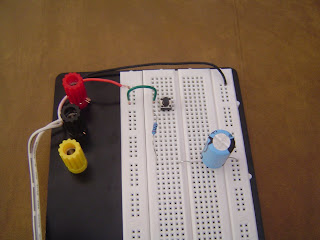 Hope everyone had a nice weekend...
Hope everyone had a nice weekend...Well, I'm now up to Exercise 9 - we're 25% done with the experiments in the book!
Exercise 9 is a fairly easy one... but don't ignore the reading. There's some very good discussion on how capacitors work, especially the part about how they are treated as if they have infinite resistance. It took a couple times reading over that for it to really sink in.
Another nice discussion was the Time Constant sidebar that starts on page 71. The math isn't difficult to follow, so do try and make sure you don't move on until you understand how it is properly calculated and used. I think the key here is the 5 X TC calculation... to get almost full charge. At that point, your capacitor is 99% charged... so again, knowing how to calculate the TC is likely to help us in future experiments when we need to know how long a capacitor takes to fully charge.
I'm including two videos here - the first shows the voltage counting up after the button is pushed. Fairly straightforward if you read the text and performed the exercise. The author tells you to short the capacitor with a 100k resistor to deplete the capacitor... but it occurred to me that you've already got a 100k resistor in the circuit to deplete the capacitor... all it requires is unplugging the AC Adapter! The second video shows the meter counting down after I've unplugged the adapter and pushed the button.
I was hoping to get Exercise 10 covered today, but I haven't had time to read over and perform the exercise yet... so I'll have that up tomorrow.
I think it would make more sense to use your meter to drain the capacitor instead of a separate resistor. It will be slower since most ohm meters have a 10-20 mohm impedance but it will drive home watching the capacitor discharge and that the meter places a load on the circuit.
ReplyDelete